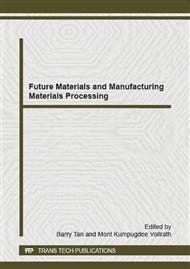p.3
p.9
p.15
p.19
p.25
p.31
p.35
p.39
Crystallite Cluster Structure Formation Resulting from Semi-Enclosed Cage Interaction in TSI-POSS/PU Hybrid Composites
Abstract:
Trisilanolisobutyl polyhedral oligomeric silsesquioxane (TSI-POSS) with three hydroxyl functional groups pendent to a semi-enclosed cage, was incorporated in concentrations of 7, 13 and 22 wt% into 4,4'-methylenebis (phenyl isocyanate) (MDI) and glycerol propoxylate to prepare TSI-POSS/PU hybrid composites as a heavy linking node in backbone, respectively. The domain micro-structures of these composites were investigated by FTIR, wide angle X-ray scattering (WAXS) and molecular dynamics simulation approach. The results indicate that with TSI-POSS concentration increasing in hybrid composites, distinct crystallite clusters are formed which increase the volume of hard segments and lead to the micro-phase separation. Meanwhile, details of chain packing has been evaluated by radial distribution function, which shows that below 13wt% TSI-POSS concentration, the number of contacts between neighboring chains is decreased due to the humping semi-enclosed cage of TSI-POSS units. However, when TSI-POSS concentration is up to 22 wt%, the number of contacts is increased because the formation of crystallite cluster pulls neighboring chains closer to each other and significantly shortens their distance.
Info:
Periodical:
Pages:
19-23
Citation:
Online since:
February 2015
Authors:
Keywords:
Price:
Сopyright:
© 2015 Trans Tech Publications Ltd. All Rights Reserved
Share:
Citation:


